How Does a Capacitor Work? Types, Uses, and Mechanics Explained
-
Pete Ortiz
- Last updated:
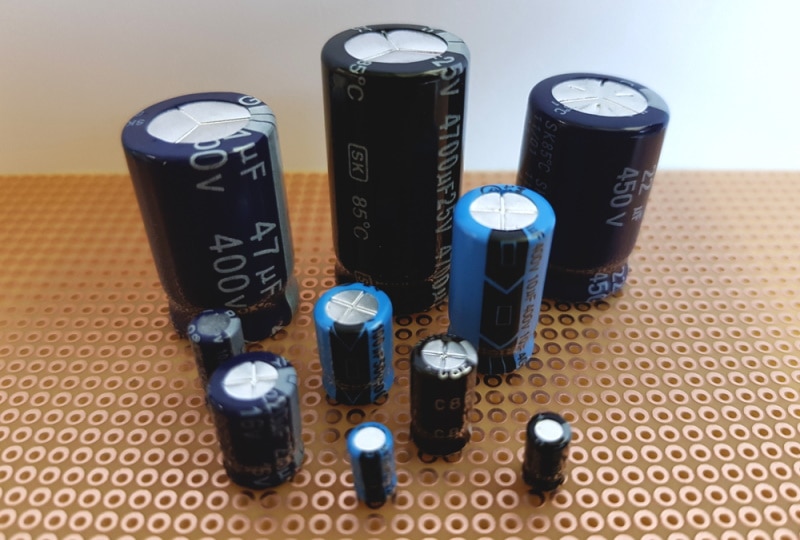
All modern electronic appliances have a capacitor or a similar device. A capacitor is a small device that charges up and temporarily stores electrical energy using an electrical field. The energy is stored in plates (usually a pair of them) separated from each other by an insulator (dielectric).
These plates act as terminals and also release energy at the same or slightly different rate as the charging speed. With the ability to store electrical energy, a capacitor may be sometimes referred to as a passive battery.
Before they became sophisticated as they are today, capacitors started out as jars filled with water. In 1745, Ewald Jürgen von Kleist discovered that a charge could be stored in handheld water jars by connecting it with a high-voltage electrostatic generator using a conductive material.
Later, when Von Klest touched the conductor, he felt a painful spark. In fact, the jot was more painful than that of the electrostatic generator. He named the jar Kleistian jar, which was later renamed Leyden jar.
The Working Mechanism of a Capacitor
As hinted, capacitors temporarily store electric energy. But before understanding how they work, we need to know their major components. A capacitor has metal plates, a dielectric material, and connection wires. A source of electrical energy, though not part of the capacitor, it is a crucial component in the system.
To work, apply an electric voltage to the two plates. The plate connected to the negative electrode (cathode) will attract negatively charged electrons. This causes a charge imbalance where negative charges will be more than positive charges. Hence, the plate will be negatively charged.
On the other plate or anode (connected to the positive terminal or electrode of the battery), electrons will move to the battery leaving the plate with more positive charges.
To prevent the metal plates from completing the circuit and releasing the charges, a dielectric material is placed in between them. A dielectric is a special material with the ability to polarize, but electrical charges will not flow through it due to a lack of free electrons or loose bonds. Polarization is the ability of a material to acquire positive or negative charges subject to the current flowing around it.

How the polarization of the dielectric insulator works in a capacitor is simple. Once a plate, for instance, has charged up or is being charged, it will attract opposite charges (negative charges) from the insulator. Because the insulator cannot leak out charges, while those of the plate move freely, more charges will accumulate around the area of the plate that is closest to the insulator. This leaves the remaining portion of the plate without charges, so to balance things off, charges will continue flowing to the plate.
When it comes to the cathode, positive charges will move closer to the dielectric, creating more room for the flow of charges. As more and more charges flow, the capacitor becomes powerful.
Basically, a material with a high polarization index forms powerful capacitors. This is why von Kleist felt a powerful jot, meaning the capacitor had accumulated more charges than the battery, partly due to a good dielectric material.
Another thing you should understand in capacitors is capacitance which is the capacity of a material to store charges, and it is measured in Farads.
Types of Capacitors
There are numerous types of capacitors on the market, each with a unique set of properties and applications.
The two basic categories of capacitors include variable and fixed capacitors.
Variable Capacitors
Variable capacitors have a capacitance value that can be altered either electronically or mechanically. The change in capacitance happens by altering the position of the movable plate. They are sometimes referred to as tuning capacitors because they are used in L/C circuits to set radio frequency.
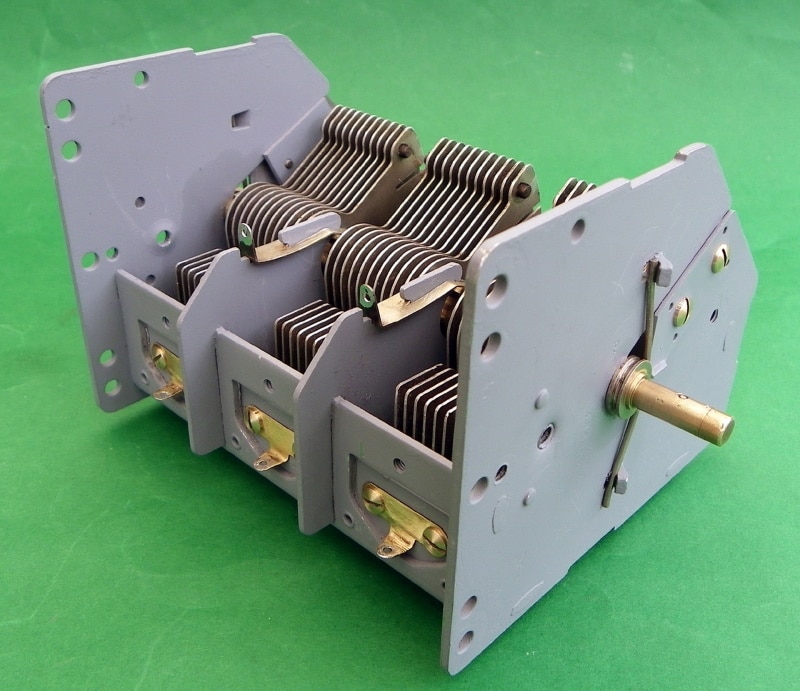
Fixed Capacitors
As the name hints, fixed capacitors have a fixed capacitance value. Their conducting plates are immobile, and thus their capacitance value cannot be changed.
Out of the two, the fixed ones are the most commonly used. Here are more categories:
- Film capacitors
- Ceramic capacitors
- Electrolytic capacitors
- Supercapacitors
- Mica options, glass, silicon, vacuum, air-gap.
These types of capacitors can be further classified into two divisions: polarized and non-polarized. For example, ceramic and film capacitors are non-polarized, while electrolytic and supercapacitors fall under polarized capacitors.
Film Capacitors
Film capacitors are non-polarized capacitors with dielectrics made of thin plastic film. The film is created using an advanced film sketching technique. Depending on the requirements for the capacitor’s characteristics, the film can either be untreated or metalized.
The advantage of film capacitors is that they are relatively cheaper than alternatives and have good stability and low inductance. Inductance is the tendency of a conductive material to oppose the change in the electric current flowing through it.
These capacitors are also divided into various categories, such as plastic film and polyester film, depending on the dielectric used.
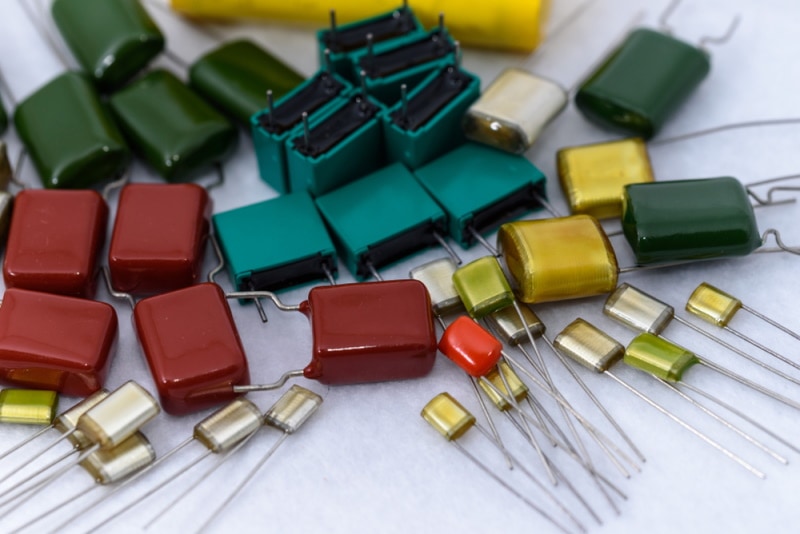
Ceramic Capacitors
Also known as disc capacitors, ceramic capacitors are usually employed in high-frequency circuits like audio to RF (radio frequency). They are the best choice for high-frequency correction in audio circuits as well.
Ceramic capacitors are made by applying silver to two sides of a ceramic disc or tiny porcelain and then stacking them together to make a capacitor. You can create both high and low capacitance in ceramic capacitors by altering the thickness of the ceramic disc used.
Ceramic capacitors come in value between a few Picofarads and one microfarad. Unfortunately, their tolerance isn’t that great, but they work perfectly for their intended purpose in life.
Electrolytic Capacitors
Electrolytic capacitors are typically employed when large capacitor values are required. One electrode consists of a thin metal film layer, and the other electrode (cathode) is made of a semi-liquid electrolyte solution that’s in the form of a paste or jelly. The dielectric plate, on the other hand, is made of a thin layer of oxide produced electrochemically and has a film thickness of fewer than ten microns.
These capacitors are mostly polarized, meaning that the capacitor terminals must receive the correct polarity when a DC voltage is supplied. If the negative terminal is connected to the negative terminal and the positive to the positive terminal, the insulating oxide layer will break due to incorrect polarization, causing permanent damage. The polarity of all electrolytic capacitors is clearly indicated with a negative sign to show the negative terminal, and the polarity should be observed.
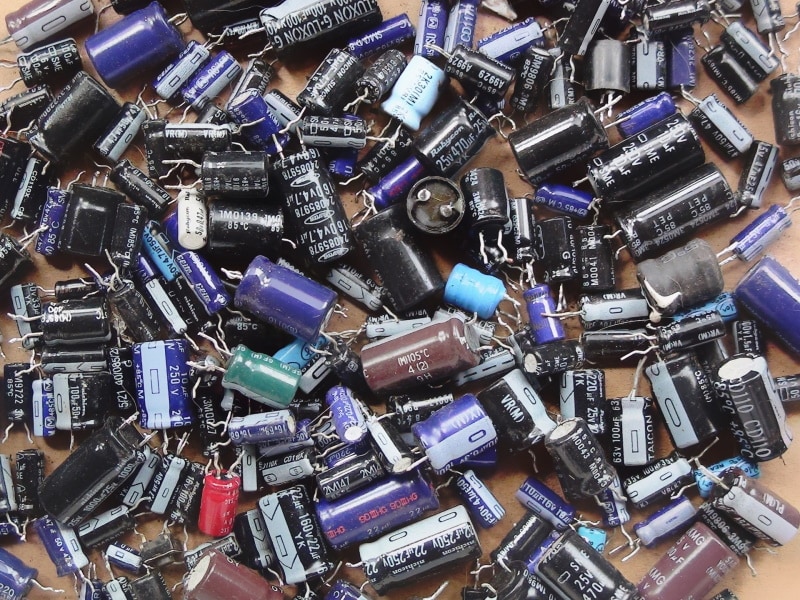
Super Capacitors
Also known as “super cap” or “ultra-capacitor,” these capacitors deliver high amounts of capacitance said to be up to several thousand Farads. They are common within systems that need a memory hold-up supply, as well as in automotive applications.
Silver Mica Capacitors
These capacitors use mica, a class of natural minerals, as dielectric sandwiched between two metal sheets. Mica’s unique crystalline structure facilitates the production of extremely thin dielectric layers. These capacitors are well known for their reliability and stability at low capacitance values. They are also non-polarized.
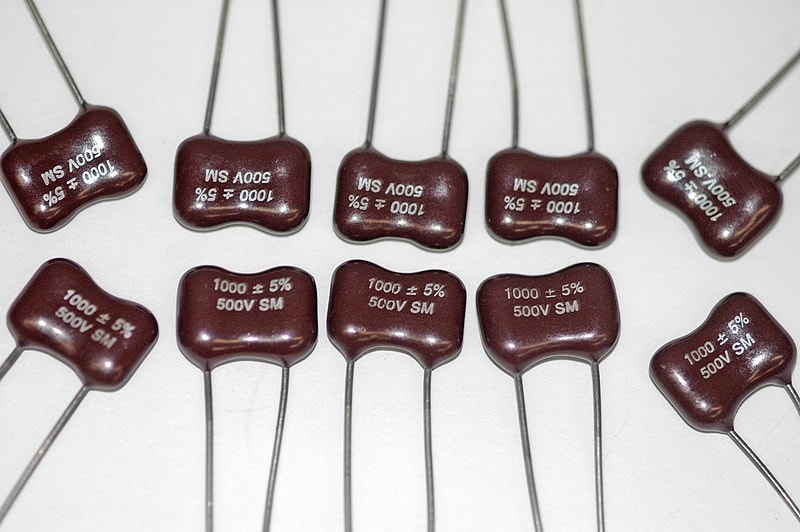
Glass Capacitors
As the name suggests, these capacitors use glass as the dielectric. Due to their minimal loss, performance is impeccable. Glass capacitors can handle large RF currents as well. They are considered among the market’s most costly capacitors due to their structure and application.
What Are the Uses of Capacitors?
Capacitors have many uses in any system that has electronic components.
1. Energy Storage
From the definition, capacitors store electrical energy for future use. In fact, Benjamin Franklin, a scientist who coined the word “battery,” used capacitors (Leyden jars) to store electricity.
Today, in audio car systems, capacitors temporarily store energy for the amplifier.
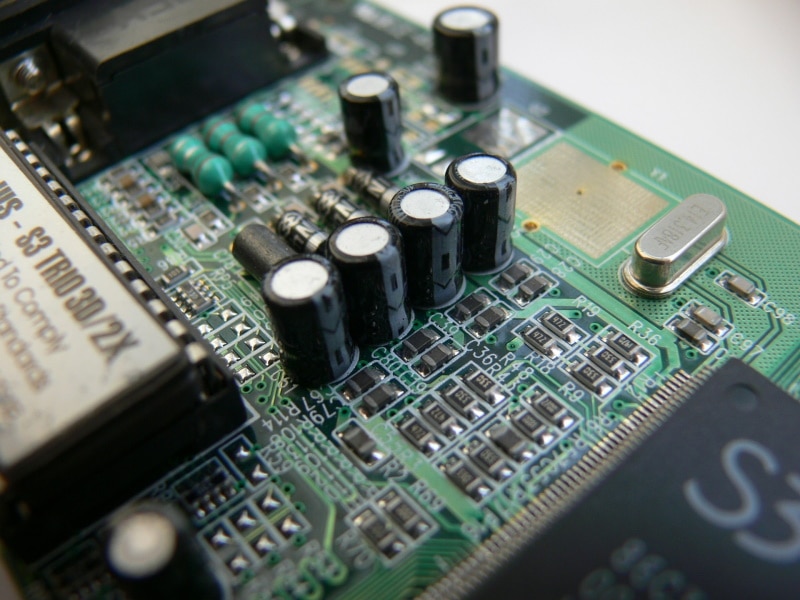
2. Pulsed Power
Pulsed power is a field of electrical science that involves large capacitors and the accumulation of energy. The capacitor charges up for a prolonged period, after which it releases the energy at once. The energy released is so powerful that it is used in water treatment.
3. Weapons
Large capacitors are used to power exploding-bridge wire detonators (EBW). An EBW is a type of detonator used to initiate a reaction in an explosive material by controlling the release of current precisely. Due to the reliability and timeliness of EBW, many countries use them in nuclear bombs.
4. Sensors
Capacitors are used in many sensors, such as humidity and fuel level sensors. To achieve that, two variables, the distance between metals and the type of dielectric, come into play.
The latter is used to detect humidity because changes in water vapor in the air may expand or contract the dielectric. These changes affect the capacitance that the device records and translates as changes in atmospheric pressure. In contrast, the former is used to define physical changes such as acceleration.
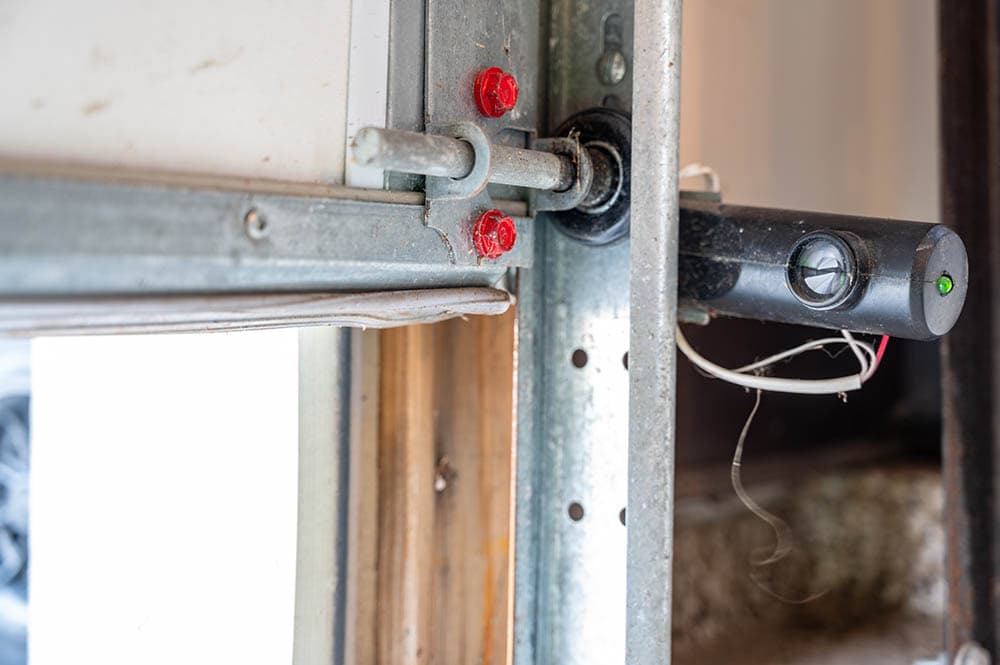
5. Power Conditioning
Power condition is the process of removing DC signals from a power line. This happens when a charged capacitor allows AC signals to flow through but prevents DC signals. The reason for removing DC signals is they cannot be stepped up in a transformer and can’t travel far without losses.
- Stores energy faster
- Reduces voltage drops
- Capacitors have a long life
- They are cheap compared to a battery
- Works with both AC and DC
- Its applications are in many fields
- Stored energy depletes quicker
- Limited storage capacity
- Cannot work without an immediate source of electricity
Conclusion
A capacitor is a device that was invented in the 1700s to temporarily store electrical energy. Its main components are two plates with opposite charges separated by a dielectric. The type of dielectric and distance between the plates determines how powerful the capacitor will be.
Among its many applications, they are used in detonators, cleaning power lines off DC signals, sensors, and storing electrical energy.
- https://www.si.edu/newsdesk/releases/benjamin-franklins-pioneering-electrical-work-influenced-todays-technology#:~:text=Franklin%20discovered%20that%20by%20linking,term%20in%20relation%20to%20electricity.
- https://byjus.com/physics/capacitor-and-capacitance/
- https://web.archive.org/web/20071024034729/http://www.worldwideschool.org/library/books/sci/history/AHistoryofScienceVolumeII/chap49.html
- https://libraries.mit.edu/collections/vail-collection/topics/electricity/the-leyden-jar/
- https://motifcap.com/capacitors-benefits#:~:text=in%20numerous%20ways.-,Capacitors%20provide%20tremendous%20benefits%20to%20distribution%20system%20performance.,capacity%2C%20and%20reduce%20voltage%20drop.
- https://www.electronics-notes.com/articles/basic_concepts/capacitance/capacitance.php
- https://www.techwalla.com/articles/uses-capacitors
- https://blog.ucsusa.org/mark-specht/the-current-war-why-did-westinghouse-ac-beat-edison-dc/#:~:text=Since%20there%20was%20no%20way,systems%20inferior%20to%20AC%20systems.
- https://www.elprocus.com/what-is-a-variable-capacitor-construction-types-and-applications/
Featured Image Credit: matej_z, Shutterstock
Contents



